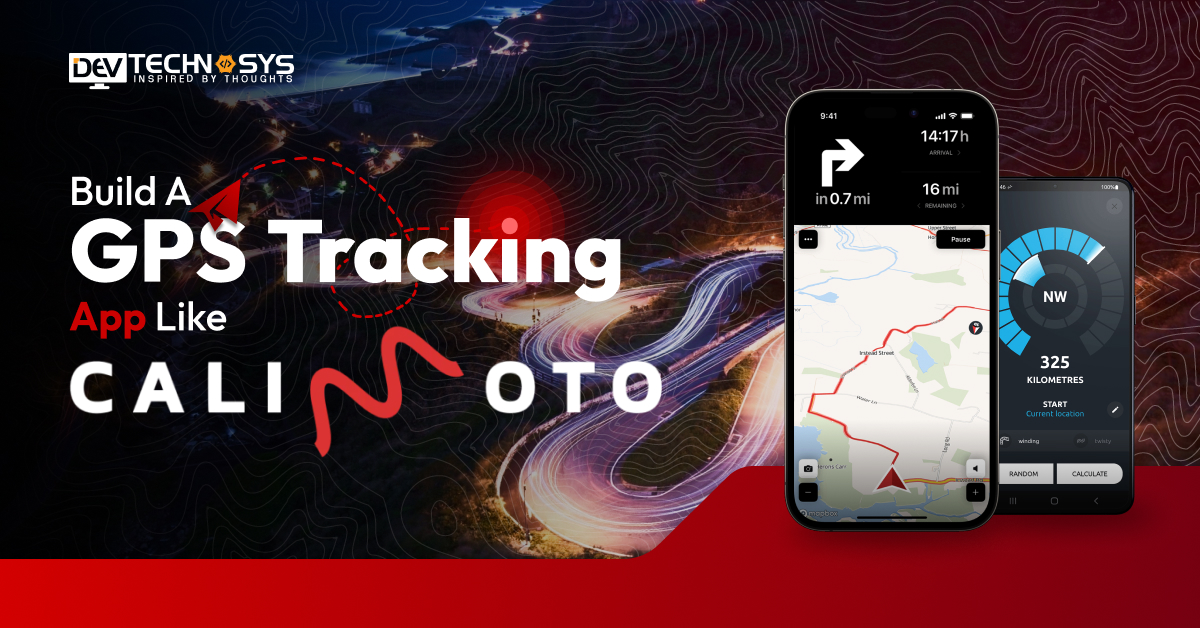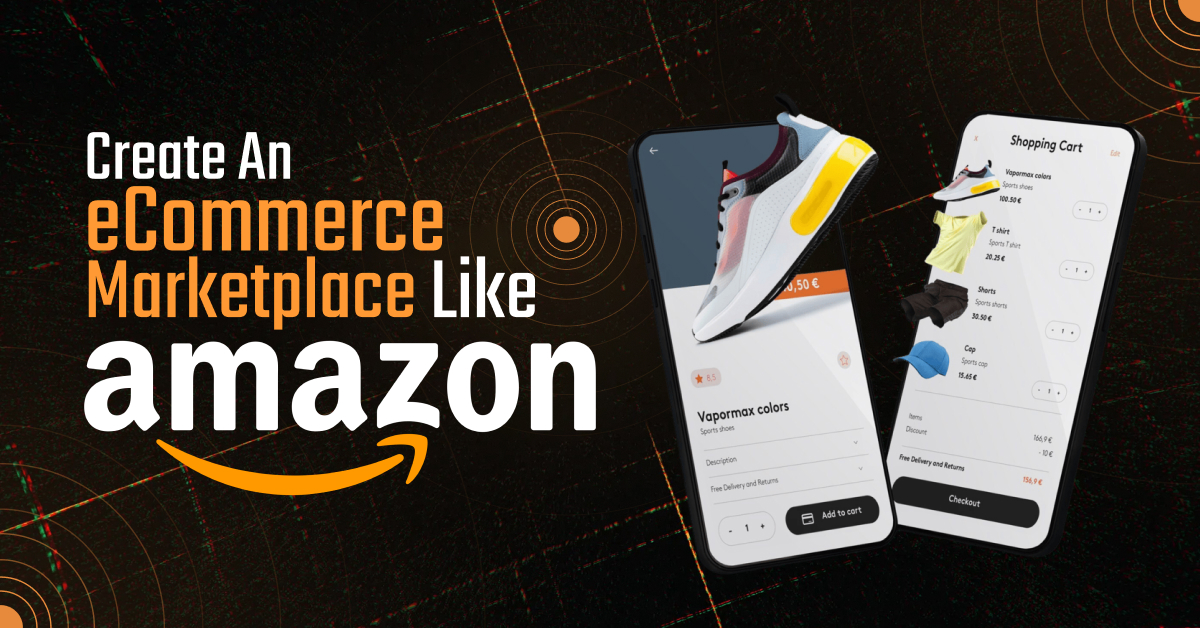In the automotive industry, one of the most complex and difficult tasks is managing repair and maintenance services. Small to large garage owners want to streamline their repair operations and improve accuracy and customer satisfaction. That’s why automotive garage software is in high demand in this fast-paced world. It allows car repair garages and service centers to manage their inventory, receive online appointments, order management, and reduce manual or human errors.
According to a global ground report, the automotive garage software was valued at around $19.6 billion in 2023; it is expected to increase to around $36.8 billion by the end of 2032.
The above data shows that building automotive garage software is a lucrative opportunity for entrepreneurs to expand their businesses to the next level.
Get ready to explore how to build automotive garage software, development cost, essential functionalities, cost-affecting factors, and more.
What is Automotive Garage Software?
Automotive garage software is a specialist program designed to assist auto repair firms in managing their everyday operations. It simplifies duties such as appointment scheduling, work order administration, inventory control, billing, customer relationship management (CRM), and staff payroll.
This software increases efficiency, lowers errors, and boosts customer happiness by automating and organizing numerous areas of the firm. If you build an auto repair shop management software, it can also generate reports, track vehicle service history, and integrate with diagnostic instruments for a more efficient repair process.
- Work Order Management
- Inventory Management
- Employee and Payroll Management
- Reporting and Analytics
Market Analysis of Automotive Garage Software
- By the end of 2032, the automotive garage software is predicted to have grown from its 2023 valuation of approximately $19.6 billion to approximately $36.8
- According to a recent survey, automotive garage software is expected to grow at a compound annual growth rate of 20% from 2024 to 2032.
- As per the study, North America holds the largest share of automotive garage software in the global market.
- According to a deep knowledge, the cloud-based category is one of the most used in automotive garage software in 2024.
- The key players of automotive garage software are Real-Time Labor Guide, Scott Systems, NAPA, Mitchell1, ALLDATA, Marketing Automotriz 360° | Marketing Para Motores, and CarVue Ltd.
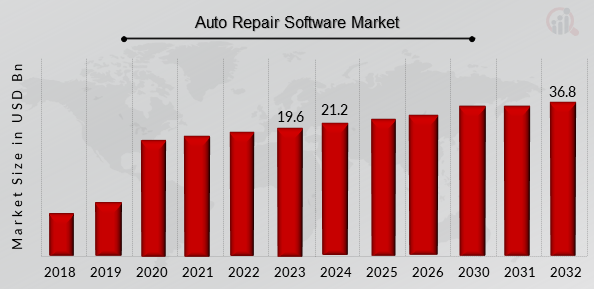
10 Superior Automotive Garage Software
These auto repair business software solutions offer a range of features tailored to optimize operations in automotive repair shops. Here’s a table with 10 superior automotive garage software options, their special features, and launch years:
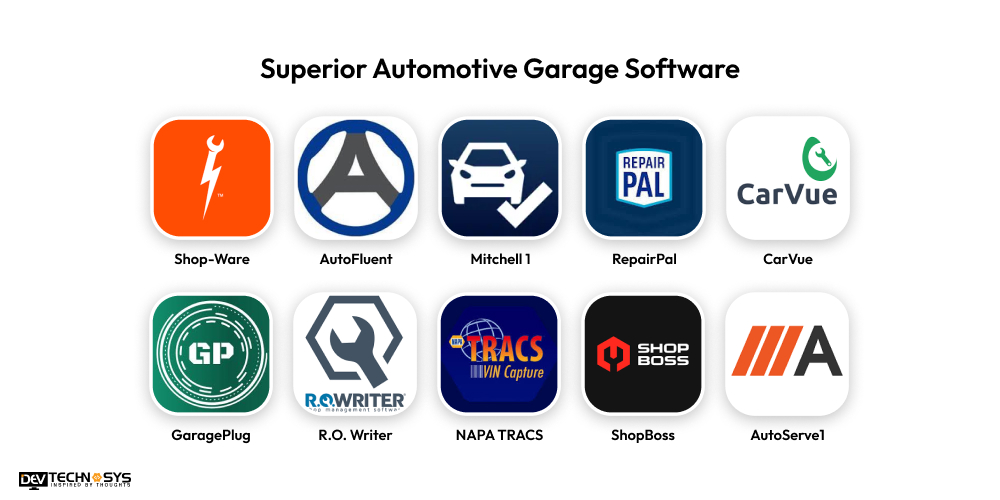
| Software | Special Features | Launched Year |
| Shop-Ware | Cloud-based, real-time updates, integrates with accounting software. | 2016 |
| AutoFluent | Customizable, inventory tracking, integrates with QuickBooks. | 2009 |
| Mitchell 1 | Repair information database, service tracking, customer management. | 1998 |
| RepairPal | Price transparency, customer reviews, diagnostic tool integration. | 2007 |
| CarVue | Cloud-based, real-time communication, appointment scheduling. | 2014 |
| GaragePlug | Multi-location support, mobile app, invoicing, and payment integration. | 2016 |
| R.O. Writer | Job tracking, inventory management, integrated point of sale. | 1994 |
| NAPA TRACS | Part sourcing, labor tracking, custom reporting, customer database. | 1996 |
| ShopBoss | Cloud-based, scheduling, invoicing, and real-time updates for technicians. | 2014 |
| AutoServe1 | Digital vehicle inspections, customer communication, and repair recommendations. | 2014 |
Why Do Most Businesses Invest in Automotive Garage Software Development?
Most businesses invest in automotive garage software development because it significantly improves operational efficiency, customer satisfaction, and financial management. Investing in automotive garage software ultimately allows businesses to stay competitive, deliver high-quality service, and scale efficiently in a fast-paced industry. So, here we provide the benefits of automotive repair shop software:
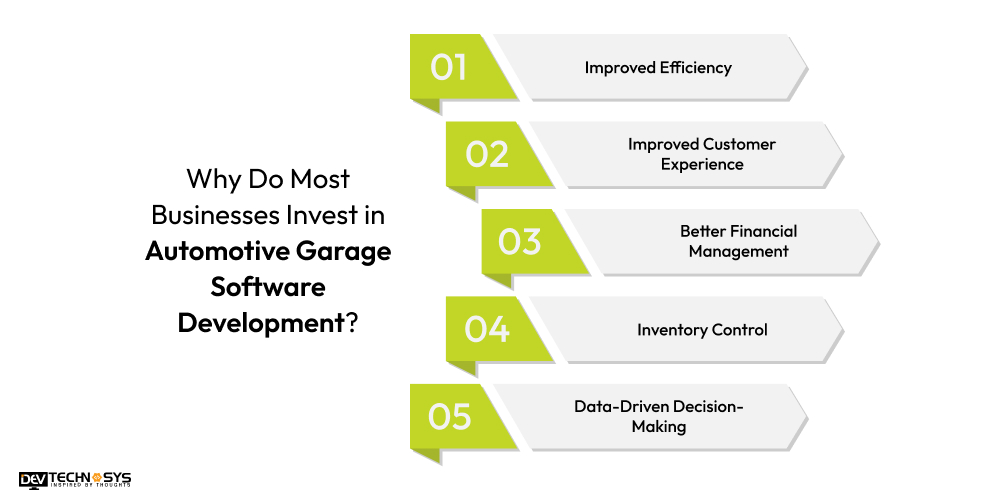
1. Improved Efficiency
Appointment scheduling, repair order monitoring, and inventory management are among the duties that automotive garage software automates. This automation lowers human error, optimizes workflows, and ensures that activities are done on time, allowing garages to manage more customers and repairs while maintaining quality.
2. Improved Customer Experience
The software helps organizations manage client interactions more effectively by tracking service history, preferences, and contact information. This enables individualized service, frequent reminders for maintenance, and speedier communication, resulting in increased client satisfaction and loyalty. In addition, several systems include online booking, letting consumers schedule services at their convenience.
3. Better Financial Management
The car workshop management system streamlines financial procedures such as billing, invoicing, and payroll. It can automatically compute labor costs, manage payments, and integrate with accounting software. According to the SaaS application development company, this reduces errors and ensures that firms have a consistent cash flow while lowering the danger of financial mismanagement.
4. Inventory Control
Managing components and tools is a major challenge for every auto shop. Businesses can use specific software to easily maintain inventory, monitor stock levels, and even create automated reorder points. This guarantees that garages always have the right parts on hand, without overstocking or running out of critical components.
5. Data-Driven Decision-Making
Many automotive garage software packages provide comprehensive reporting and analytics tools. These capabilities enable business owners to track performance measures including revenue, customer satisfaction, and repair efficiency. Businesses that comprehend these insights can make better decisions to improve operations, cut costs, and boost profits.
7 Knowledge Steps to Build Automotive Garage Software
To develop automotive garage software, there are robust development stages that can enhance the business experience to easily understand the overall process. From designing to post-launch services, we offer every stage; this can avoid confusion and create error-free software. So, here we provide the successful automotive software development process:
- Define Requirements and Demands
- Features and Functions
- Tech Stacks
- Design UI/UX
- Software Development
- Testing and QA
- Launching and Maintenance
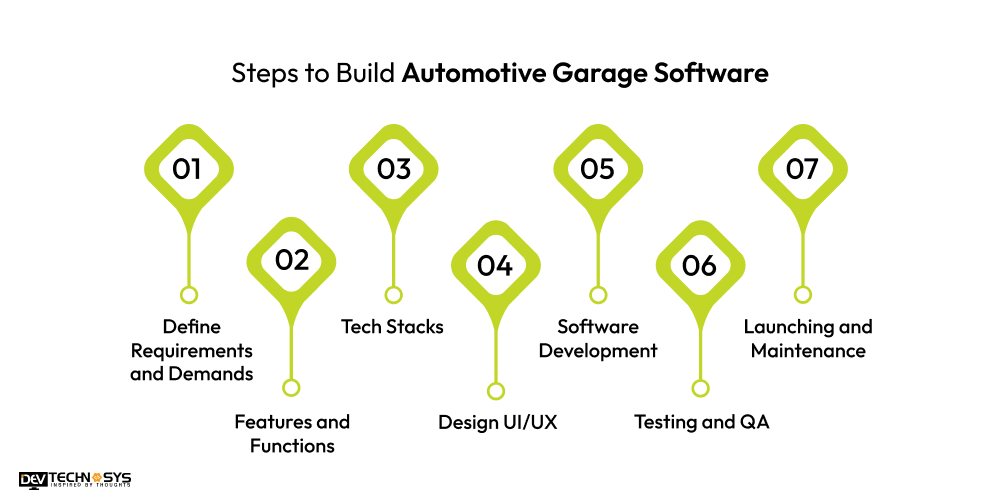
1. Define Requirements and Demands
Let’s start the first custom software development process and identify the specific needs of the garage, including user expectations, business processes, and regulatory requirements. Gather input from stakeholders to create a clear set of functional and non-functional specifications for the software.
| What are your project’s basic or core requirements? |
| Define your future goals. |
| Which automotive garage software is more trending in this competitive market? |
2. Features and Functions
In the second development step, outline the essential features the software should have, such as appointment scheduling, billing, inventory management, and reporting. Ensure the functionalities meet user needs and align with the goals of the automotive garage.
| What are your project’s basic features and functions? |
| Analyze the popular automotive garage software. |
| Make an organized sheet of features and functions to reduce confusion. |
3. Tech Stacks
Hire experienced developers from door to door car service app development company to choose appropriate technologies (programming languages, databases, frameworks, etc.) based on the software’s requirements. Consider factors like scalability, compatibility, security, and performance to ensure a robust and reliable system.
| Which type of tech stacks are used in your auto repair shop software development? |
| Define your scalability requirements. |
| Choose advanced or core tech stacks. |
4. Design UI/UX
Create an intuitive, user-friendly interface that enhances the user experience. Design wireframes and prototypes that prioritize ease of use, clarity, and efficiency for both customers and garage staff.
| What are wireframes in UX design? |
| What tools do you use for prototyping? |
| How do you ensure a responsive design? |
5. Software Development
Begin coding the application based on the design and tech stack decisions. Hire software developers to develop both front-end and back-end components, integrating essential features like data storage, payment gateways, and customer management systems.
| How to process backend services? |
| Choose the experienced developers. |
| Implement a high number of features and functions. |
6. Testing and QA
Conduct robust software testing services, including functional, usability, performance, and security tests. Ensure the software works as intended and meets quality standards, identifying and fixing bugs before release.
| Make sure that all features and functions are working properly |
| Use various testing methods, such as unit and security testing |
| Implement robust security methods |
7. Launching and Maintenance
Deploy the software to the production environment, ensuring it functions properly. After launch, offer ongoing maintenance and updates, addressing bugs, adding new features, and improving performance based on user feedback.
| Launch your software on the live phase. |
| Use the best marketing techniques to promote the software. |
| Assign the post-maintenance phases to maintain the software performance. |
10 Must-Have Features of Automotive Garage Software
These features help automotive businesses improve productivity, reduce operational errors, and deliver a superior customer experience. Here are 10 must-have essential features of car workshop management software.
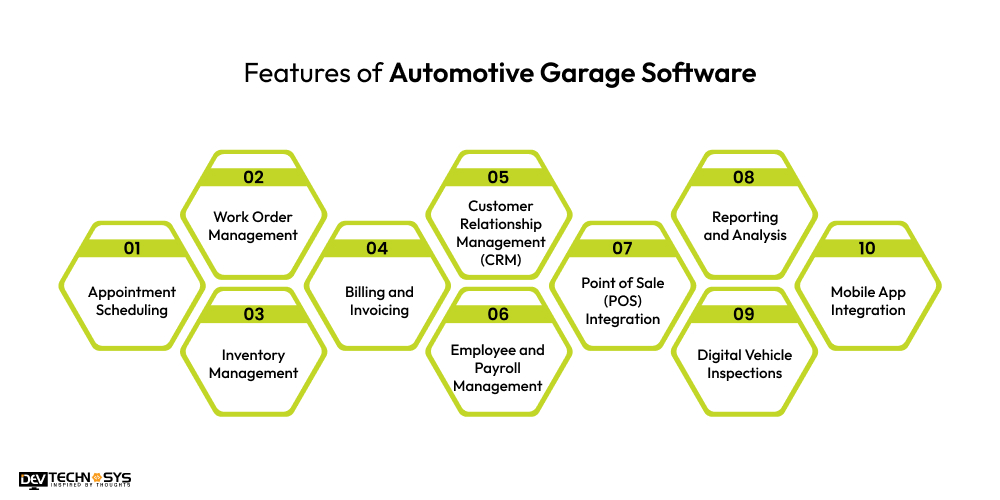
1. Appointment Scheduling
Customers can arrange service appointments online or over the phone, which helps the garage manage time and prevent overbooking.
2. Work Order Management
Tracks repair orders, job status, and completion to ensure openness and accountability for both professionals and consumers.
3. Inventory Management
Keeps track of components, tools, and supplies, alerting you to low stock levels and preventing delays caused by unavailable parts.
4. Billing and Invoicing
Automates invoice creation, payment tracking, and integration with accounting systems to reduce errors and improve financial management.
5. Customer Relationship Management (CRM)
Stores the customer contact information, service history, and preferences, enabling individualized service and follow-up.
6. Employee and Payroll Management
Manages employee schedules, tracks work hours, and automates payroll to ensure that employees are paid accurately and on time.
7. Point of Sale (POS) Integration
Simplifies payment processing, whether using credit cards, digital wallets, or cash, and connects with the whole financial system.
8. Reporting and Analysis
Produces precise information on financial performance, service efficiency, and inventory status, allowing businesses to make informed decisions.
9. Digital Vehicle Inspections
If you develop an automotive website, it Allows technicians to complete and share car inspections digitally, giving consumers greater transparency and better communication.
10. Mobile App Integration
Staff may access job details, customer information, and work orders while on the road, ensuring that operations run smoothly even while they are away from the office.
What is the Cost to Build Automotive Garage Software?
The cost to make automotive garage software varies according to features, complexity, and location of development. On average, a simple software development cost between $8,000 and $15,000, but more powerful systems with specific features might cost $18,000 to $25,000 or more. Integrations, user interface design, database management, and continuous maintenance are all significant cost drivers. When planning for development, take into account the long-term expenses of updates, support, and scalability.
Cost to Develop Automotive Garage Software
| Automotive Garage Software Development
|
Estimated Cost | Time Frame |
| Basic Software Development
|
$8000 – $13000 | 2 to 5 Months |
| Mid-Premium Software Development
|
$12000 – $20000 | 6 to 8 Months |
| High-Premium Software Development
|
$25000+ | 9+ Months |
5 Major Factors That Affect Automotive Garage Software Development Cost
When building automobile garage software, various factors influence the final cost. Here are five significant aspects influencing the development price:
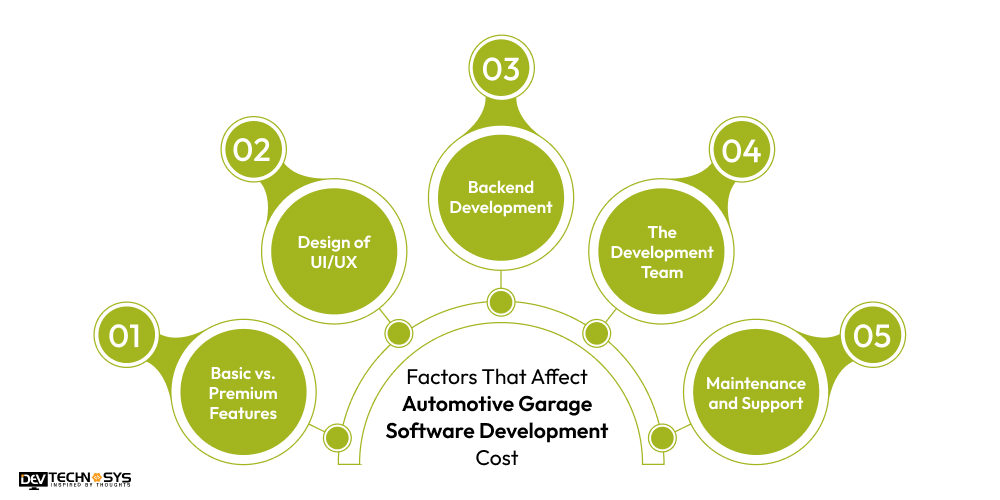
1. Basic vs. Premium Features
The software’s features have a direct impact on its pricing. Basic functionality, such as appointment scheduling or customer administration, is less expensive. Premium services, such as integrated payment gateways, invoicing, inventory management, and complex reporting tools, demand additional development time and technical knowledge. The more complicated features can increase the overall automotive software development cost.
| Features | Cost Estimation |
| Core Features(Appointment Scheduling and Inventory Management) | $8,000 – $13,000 |
| Advanced Features(Integrated Payment Gateways and Real-Time Inventory Tracking) | $15,000 – $19,000 |
2. Design of UI/UX
The user interface (UI) and user experience (UX) design are critical to the software’s success. A simple and intuitive design with minimal functions will be less expensive than a complex, custom UI/UX that provides a smooth, visually pleasing experience. Custom designs involve additional time for user research, wireframing, prototyping, and testing, which raises the final cost to create a vehicle service management system.
| Design Quality | Cost Estimation |
| Basic Design | $8,000 – $12,000 |
| Complex Design | $15,000 – $22,000 |
3. Backend Development
A strong backend is required for garage management software to perform efficiently, particularly with data management, storage, and system integrations. Creating a secure, scalable, and efficient backend takes more time and effort, making it one of the most costly components of development. Complex back-end infrastructure, including real-time data processing and third-party connections, raises the cost to create automotive garage software.
| Backend Development | Cost Estimation |
| Basic Backend Process | $10,000 – $18,000 |
| Premium Backend Process | $20,000 – $28,000 |
4. The Development Team
The type and location of the development team have a considerable impact on expenses. Hiring a highly qualified team of engineers, project managers, and designers from a top-tier organization is more expensive than outsourcing to a freelancer or an offshore software development company. Furthermore, the team’s location matters; development expenses are often higher in North America and Western Europe than in Asia or Eastern Europe.
| Developer’s Location | Cost Estimation |
| Asia Pacific | $8,000 – $15,000 |
| North America | $15,000 – $20,000 |
| Eastern Europe | $13,000 – $18,000 |
| Western Europe | $16,000 – $25,000 |
5. Maintenance and Support
After the software is released, continual maintenance and support are required to maintain the system up to date, repair issues, and answer customer feedback. This necessitates a specialized workforce and incurs recurring expenses. Regular updates, server administration, bug patches, and feature additions are common car maintenance software development tasks that must be factored into the overall budget.
| Maintenance Phase | Cost Estimation |
| Simple Maintenance Phase | $2,000 – $4,000/year |
| Complex Maintenance Phase | $8,000 – $10,000/year |
5 Money-Generating Techniques of Automotive Garage Software
Custom automotive software solutions provide a variety of revenue opportunities for both the business and the software developers. Here are five revenue-generating strategies for car garage software:
- Subscription Model
- Premium Features and Add-ons
- Advertising and Promotion
- Data Analysis and Insights
- White Labeling and Licensing
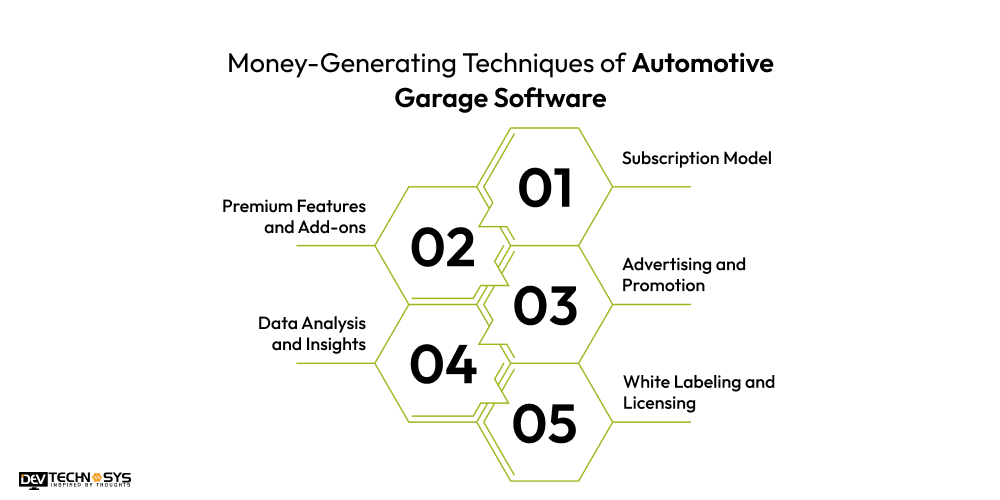
1. Subscription Model
Subscription-based pricing is one of the most prevalent ways to generate revenue. Garage owners pay a monthly or annual fee to utilize the software, which includes functions like as scheduling, customer management, and reporting. This provides a consistent, ongoing revenue stream for the software vendor while garages profit from predictable costs for using the system. Tiered subscription levels (e.g., Basic, Professional, Premium) can accommodate a variety of business sizes and budgets, providing scalable price alternatives.
2. Premium Features and Add-ons
In addition to basic functionality, giving premium capabilities as add-ons is a common strategy. Additional premium services may include extensive analytics, real-time inventory tracking, or connected payment methods. This technique allows garages to tailor the program to their own needs while increasing earning prospects for the software firm.
3. Advertising and Promotion
Incorporating adverts or promotional features into the software can lead to increased revenue. The program allows garages to display adverts from third-party suppliers as well as promotions relating to automotive products and services. Software product development providers can also collaborate with car part suppliers, service providers, and insurance firms to provide deals via the platform, receiving a commission on each sale or lead generated.
4. Data Analysis and Insights
Vehicle service management software captures vital information about client behavior, service patterns, and inventory consumption. This data can be anonymized and aggregated before being sold to manufacturers, suppliers, or market research firms seeking insights into the automotive sector. Offering this data as a premium service or selling it outright can generate big cash.
5. White Labeling and Licensing
For larger software companies, white-labeling or licensing their platform to other businesses can be a profitable revenue source. This entails letting other companies to brand and sell the software under their own names. Licensing the software to other industries (such as automobile rental companies or fleet management services) broadens its market reach and creates new revenue prospects.
Conclusion
We are standing at the last phase of this blog. Building vehicle service management software offers significant benefits, from streamlining operations to enhancing customer service. It offers various advanced key features like scheduling, inventory management, and customer relations, businesses can boost efficiency and profitability. The development process requires careful consideration of costs, the choice between basic and premium features, and ongoing maintenance.
If you want to develop automotive garage software, then you can connect with a leading automotive software development company to receive cost-effective development solutions.
Frequently Asked Questions
1. How Much Does It Cost To Build Automotive Garage Software?
The cost to build automotive garage software can range from $8,000 to $25,000+, depending on features, complexity, and development location. Customization, integrations, and scalability impact pricing significantly.
2. How Much Time Does It Take To Make Automotive Garage Software?
To create automotive garage software, it takes 3 to 9 months, depending on complexity, features, and customization. More complex systems with integrations and scalability may necessitate more time for development and testing.
3. Is a Car Garage a Profitable Business?
Yes, a car garage can be a profitable business, especially given the high need for vehicle maintenance, repairs, and services. Profitability is determined by location, service offerings, client loyalty, and operational efficiency.
4. What are the Core Functionalities of Automotive Garage Software?
Vehicle management, appointment scheduling, invoicing, payment integration, inventory tracking, service history records, customer management, reporting, and analytics are all core capabilities of vehicle service management software that help to streamline operations and improve productivity.




















